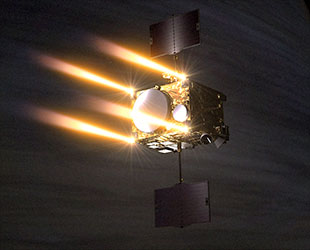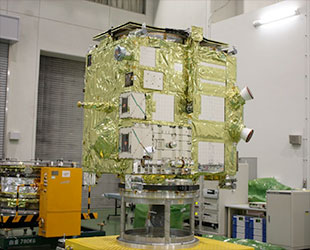Dec. 7, 2015 — A Japanese space probe made a second attempt at orbiting Venus on Sunday (Dec. 6), five years to the day after its first try to circle the planet failed.
Japan's Akatsuki ("Dawn") spacecraft fired its four attitude thrusters for about 20 minutes on Sunday (Monday, Dec. 7 local Japan time) in a bid to be captured by Venus' gravity. Though mission managers were able to confirm the probe completed the burn as expected, it will take another a few days to verify Akatsuki's orbit.
"As a result of analyzing data transmitted from the orbiter, we [have] confirmed that the thrust emission of the attitude control engine was conducted for about 20 minutes as was scheduled," officials with the Japan Aerospace Exploration Agency (JAXA) said in a statement on Sunday night.
"The orbiter is now in good health," the JAXA officials said. "We are currently measuring and calculating its orbit after the operation."

Artist's depiction of Akatsuki entering Venus' orbit by firing its four small attitude thrusters. (Go Miyazaki) |
Akatsuki, also known as Venus Climate Orbiter, was never intended to use its small attitude thrusters to enter orbit. Its main engine however, failed less than three minutes into a planned 12-minute orbital insertion burn when the probe first attempted to begin circling Venus on Dec. 6, 2010.
Instead, the spacecraft was found in a safe mode, slowly spinning as it sailed off into space. An investigation found the likely cause to be salt deposits in a check valve, which starved the orbital maneuvering engine of fuel and created an oxidizer-rich combustion environment that damaged the its combustion chamber's throat and nozzle.
Mission managers put the probe into hibernation to extend its lifespan as it revolved around the sun, using the time before its next encounter with Venus this week to develop a recovery plan. The smaller attitude thrusters did not have enough power to place Akatsuki into its originally intended orbit, but the mission is still expected to accomplish much of the science it was set out to do.
Akatsuki though, will be studying Venus from much farther away on average than first planned. Its new highly-elliptical orbit will have a period of eight or nine days instead of 30 hours, and it will take the probe as far away from Venus as 186,000 to 250,000 miles (300,000 to 400,000 kilometers), as opposed to 50,000 miles (80,000 km) as was targeted five years ago.

The Akatsuki Venus Climate Orbiter as seen before launch. (JAXA) |
Akatsuki was launched in May 2010 to make observations of Venus' clouds, weather and atmosphere for at least two years to learn more about the Earth's "twin sister" through remote sensing. Equipped with five cameras, including an infrared imager and an ultraviolet instrument, Akatsuki will also monitor lightning and airglow on the planet.
Akatsuki is Japan's second-ever interplanetary probe. The first, Nozomi, failed to enter orbit around Mars in 2003.
Akatsuki is the seventh spacecraft in history to orbit Venus following probes that were launched by Russia, the United States and Europe. It is now the only craft to be circling the second planet from the Sun. Europe's Venus Express, the most recent probe prior to Akatsuki, ended its mission in late 2014 after operating for eight years.
